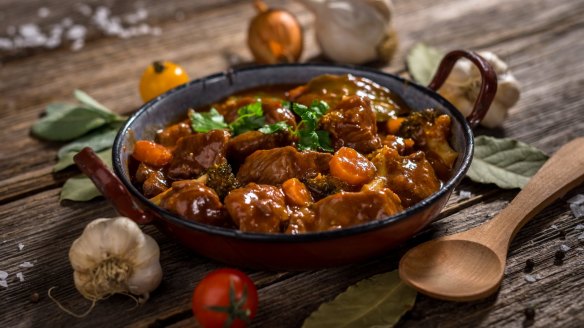How to thicken a stew without using flour

How do I thicken a stew without using flour? I have become gluten-intolerant. P. Banks
I remember staying at a friend's place and his mum was a spendthrift cook. She was tight. Real tight. She'd spread margarine on your toast so you wouldn't use "too much". Not that you would. It was no-name brand and tasted like an oil refinery. She would make a stew made with equal parts beef and flour, giving it the colour and consistency of Clag. Since then, I have always steered clear of that method. When you cook down the mirepoix – diced carrot, onion and celery – it will eventually create a dense sauce. However, to stop cooking the nutrients out of the vegetables, I remove the meat from the pot, set it aside, and blitz the veg with a stick blender before returning the meat to the pot. You can also use rice flour or potato starch, but I prefer the following method. Peel a potato. Chop it up. Put it in a blender with half a cup of water and blitz until it has formed a smooth liquid. When your stew has cooked down and the meat is soft enough, add the potato water to the stew and stir through over medium heat until the potato tastes cooked and stew has thickened.
How do I know whether my food contains palm oil? I. Grimley
You can't. The food industry has fought tooth and nail to avoid mandatory listing of palm oil on product labels. Palm oil production is responsible for the destruction of forests throughout south-east Asia. It will be listed among the ingredients on food labels as "vegetable oil" and in household products by any one of 20 different names, including stearic acid and sodium lauryl sulphate. It is commonly used in biscuits as shortening and confectionery to add a buttery mouthfeel. As pioneering celebrity chef Gabriel Gate once said: "Never buy anything in a packet except pasta and canned tomatoes."
Can you please advise me of any Australian-made noodles. If so, the brand and maker and where they are available? A. Ryan
My late grandfather lived in Nuriootpa in the Barossa Valley. Living in the east, I'd travel to see him twice a year. We'd poke about the hills looking at old stone buildings and he'd tell me outrageous stories about growing up in an age without seatbelts, drink-driving laws or any sense of political correctness. We'd stop at the usual places so I could fill up my suitcase with Barossa foods. There was German cake from the Tanunda Bakery, mettwurst from Linke's Butcher in Nuriootpa and noodles from Weich's Barossa Valley Egg Noodles. Still made today, they cook to a beautiful soft consistency and work as well in a soup as they do as a pasta dish. You can order them online at Farmhouse Direct, farmhousedirect.com.au.
Letters
Dear F. Mahony of Brighton in Victoria. Thank you so much for sending me the box of Tandaco Dry Active Yeast with a use-by date of April 1999. Just to let you know I did try to activate the yeast by putting it in warm water with a little sugar as you asked. I have some bad news. The yeast is no longer active. It has passed away.
Send your vexing culinary conundrums to brainfood@richardcornish.com.au or tweet to @realbrainfood.
- More:
- Food
- Brain food
